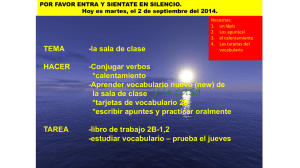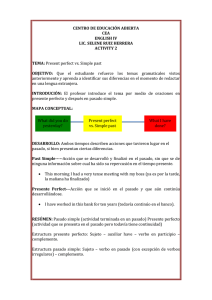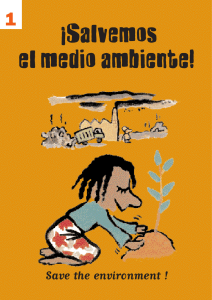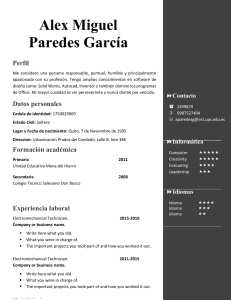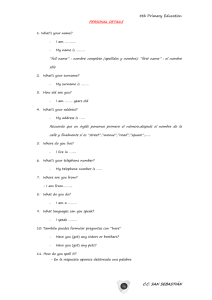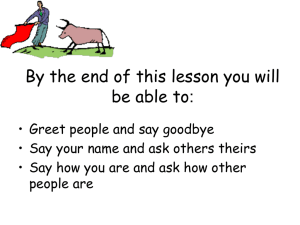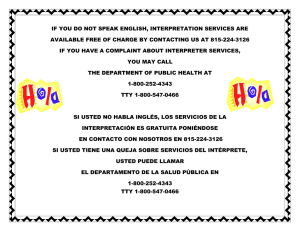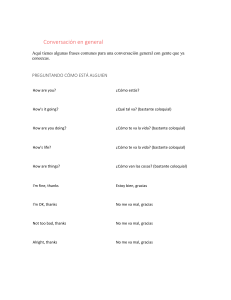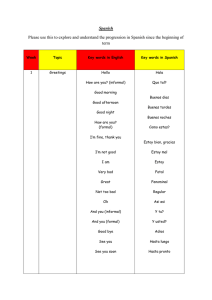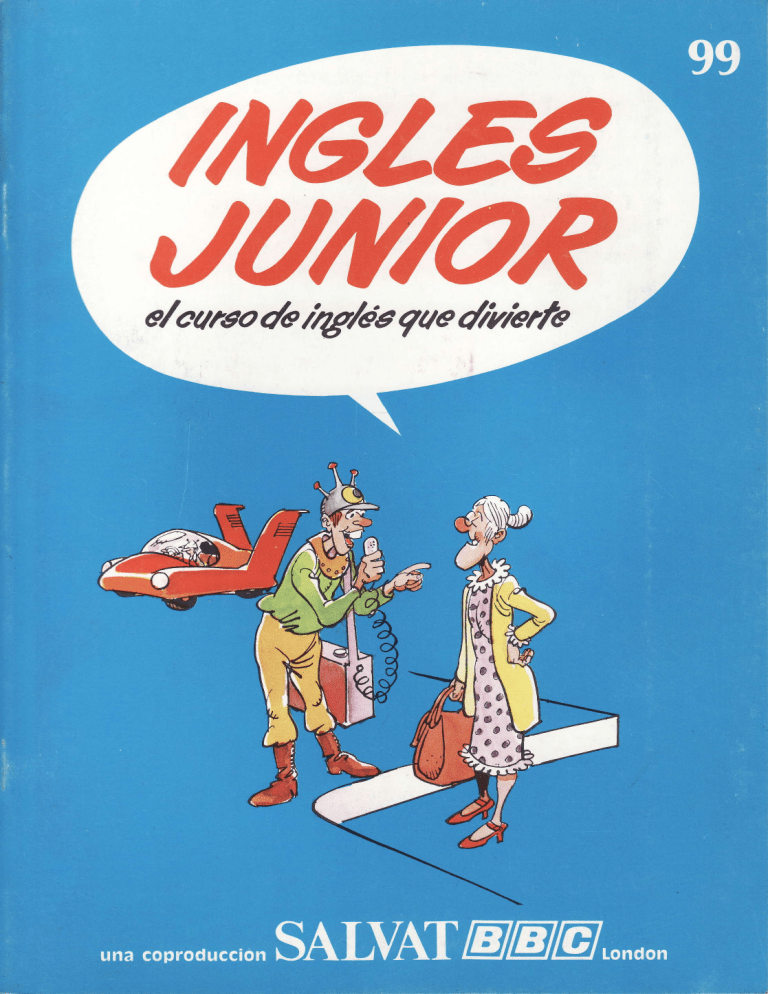
C Óuo U TILI Z A RE S T ECURS O
U NIDA DE SIMP A RE S
1) Mirad la primera página. Es una introduccióna lo que va a desarrollarseen la
unidad, y os dará a conocer algunas expresiones inglesas que se utilizarán en
ella.
2) En fa página Do you remember? encontraréis algunas expresionesaprendidas
en la unidad precedente. Mirad la ilustración y leed las expresiones.
3l Practicad las Language activities. Se componen de ¡mágenes, rimas para la
pronunciación, rompecabezas y juegos; las instrucciones se encuentran en
cada página. Muchos de estos ejercicios van acompañados de preguntas grabadas en la cassette; cuando se dé este caso, mirad la página correspondiente, escuchad la cassette y responded a las preguntas. Seguidamente, haced
prácticas sin la cassette, respondiendo a preguntas que pueden ser foimuladas por un compañero.
4) Escuchad la canción grabada en la cassette, mirad el texto y la ilustración, y
aprended a cantarla {si queréis tocarla a la guitarra, encontraréis la partitura
en la misma página). Volveréisa oír la misma canción en el comic.
5l Seguid fas instrucc¡onesde How to make it? y practicad las expresiones¡nglesas con el objeto que habréis construido.
6) Mirad la página de Words & Phrases y practicad con ellas. Son palabras y expresionesque -ya han sido utilizadasen la unidad.
7l En las páginas centrales hay otros rompecabezas, objetos para construir y
posters que podéis separar.
U NIDA DE S P A RE S
1) Mirad fa primera página, leed las expresionesde la página Do you remember?
y pract¡cad las Language activities como en las unidades ¡mpares.
2l Mirad las imágenes del comic. Después escuchad la cassette sin mirar las
imágenes: haced lo posible para comprender lo que está¡s oyendo. Seguidamente, mirad el comic y escuchad,al mismo t¡empo, la cassette.Podéiscantar las canciones, repetir lo que los personajes dicen, hacer algunos dibujos
reflejandolo que ha sucedidoen el comic y escribiralgunasfrases en inglés.
3l Realizadlos ejerciciosde escritura.
4) En las páginas centrales encontraréis un diccionario ilustrado que podéis separar y coleccionar.
No ofvidéis que las páginas de Language activities os ayudan a ejercitar diversos
aspectos de la lengua inglesa, y que dichos aspectos se repasan en los comics de
las unidades pares oyéndolos rodeados de otras expresiones, Recordad también
que, siempre que os sea posible,debéis practicarcon vuestrosfamiliaresy amigos las expresiones inglesas que aprendéis.
UNIT*
99
trl
YOU
HAVE
EVER
tsEEN
'11111{E
MOON
BEIOR¿?,
En esta unidad aprenderéis la expresión inglesa Have you ever ...? y también algo más sobre la manera de preguntar por un camino a seguir. Encontraréis asimismo alguna información acerca del
espacio y de las estrellas.
99/ 1
DOrcU RETTE'UT3ER?:
What's his name?
f'l
pl
lt
t,
Averíguad qué frase corresponde a cada ilustración y escribid la letra que se indica a continuación de cada frase. Sí ponéis todas las frases en el orden correcto encontraréis el nombre
del ladrón. Por eiemplo, si creéis que la ilustración número I representa "A woman is putting
a bag into a box", escribíd la V como primera
letra.
Here are the sentences:
He has gone.
A woman is putting a bag into a box.
A man is openingthe box.
She has put the bag in the box.
The man is going.
He has openedthe box.
What is the man's name?
99i2
(R)
{V)
(C)
{l)
(O)
(T)
m
IE$-
TAilGUAGE
An interview for Moon Radio.
Una entrevístapara Radio Luna.
Readthe words and listento the tape. Then listen againand say the sentences.
Reporter:
Miss Peel:
Reporter:
Míss Peel:
Reporter:
Miss Peel:
Reporter:
Miss Peel:
Reporter:
Miss Peel:
Reporter:
Miss Peel:
Reporter:
Miss Peel:
Reporter:
Miss Peel:
Reporter:
Miss Peel:
Good morning. I'm a reporter
from Moon Radio. I'd like to
interviewvou.
An interview!How interest¡ng!
Now, where have you been
today? What have you done?
I haven't been anyWhereyet.
And I haven't done anything.
l've just arrived.
How long ago did you arrive?
About an hour ago.
Have you ever been to the
moon before?
No, never.This is the first time.
Do vou likethe moon?
Well, I haven't seen it yet,
but ...
Do you like the peopleon the
moon?
Well, I haven't met many yet.
l've spoken to a few, but ...
Why have you come to the
moon?
Well, l've heard a lot about it.
And l've come to see Barrett's
Circus.
Oh yes, everyone has heard
about Barrett'sCircus.
Really?
Yes. So you like the moon,
and you like the peopleon the
moon. Thank you very much.
Yes, but ... Oh, he's gone!
I'I4 A REPORTER
MOON
RADIO.
FROM
I'D LIKE]O
What have you
done?
Have you ever been
to the moon
before?
How long ago?
meet (met-met)
speak
(spoke-spoken)
He's gone!
¿Aué ha hecho
usted?
¿Ha estado usted
alguna vez en la
luna antes?
¿Cuántotiempo hace?
encontrar
hablar
¡(Él)se ha ido!
s9/3
Answers on oage 16 .
How long ago was it?
W
re
Robin is on his bed. He is reading. lt is four
o'clock in the afternoon.
Look at the clocks in the other pictures.Can you
answerthe questions?
r
il
r
I
1.
2.
3.
How long ago did Robinwake uP?
hours ago.
How long ago did he have an Englishlesson? 4'
ago.
9s/4
How long ago did he come home from school?
.ago.
How long ago did he make a sandwich?
.....ago.
What have they bought?
Look at the two pictures.What have the people bought? Look at the example. Can you answer the
other questions?
1.
2.
3.
4.
5.
6.
78.
He has bought a hat'
What has the old man bought?
He has bought
What hasthe young man bought?
She has
What has the fat woman bought?
What has the thin woman bought?
What has the girl with short hair bought?
What has the girl with long hair bought?
What has the small boY bought?
What has the small girl bought?
99/5
PTONUNCIATION
to catch (a train)
don't worry
hurry
there's no need
to hurry
Listento the rhyme.Then listenagain
and sav each line.
Here'sanotherrhyme. Listen.
Therewas an old lady from Crewe,
Who wanted to catch the 2.O2,
A porter said:'Don't worry,
There's no need to hurrylt's a minute or two to 2.A2.'
99 /6
tomar (un tren)
no se Preocuqe
aqresurarse
no es necesario
aqresurarse
SONG
S o n g.
Oh where, oh where
has my l¡ttle
dog gone?
(J:¡9)
A¡¿anr¡no
where. oh where has
l¡t
my
ears
Esta canción data aproximadamente de 1860 y fue escríta
por un americano llamado
Septimus Winner. Es parte de
una canción más larga, pero en
la actualidad la gente no recuerda más que esfas dos estrofas.
Oh where, oh where has mY
littledog gone?
Oh where, oh where can
he be?
His eargare short and his
tail is long,
is he?
where
oh
where,
Oh
¿re
- tle
shorl
doq gone? 0h
afid
whete, oh where can
he
h¡s
ti
*;
Oh where, oh where has mY
little dog gone?
Oh where, oh where can
he be?
his
His ears are short and
tailis long,
Oh where, oh where is he?
ears
oreJas
99/1
TANGIJAGE
IES-
You can't miss it !
iNo puede equívocarseusted!
¡
\\JROf\I6
11{E
I'VÉTAKE,Ñ
ME.I'\,E UlEl-Co¡'tE,
nkunc,'|#<clbz
liC lHE
yCu
TÉ,1
@I)tD
Le51MVU/AY.
y
1l{E,
10 BAREIT'6
WAY
t'1E
oHlTlrlANK
VOUí
aR407
a turning
take the first turning
Read the words and listen to the tapeThen listenagain and say the sentences.
99/8
until
a crossroads
a roundabout
miss
you can't miss it
take (took-taken)
f've lost my way
una bocacalle, una esquina
tome usted la prímera
bocacalle
hasta
una encruciiada
un refugio, una glorieta
equivocarse, errar
no puede equivocarse usted
tomar
me he Perdido
What's the name of Mr. Field's street?
1"i';.'ij{:'.'
i;r...,;.
Answer on page 16.
UJ
f, 4
éd
É6
f^
;¡r'iiiT
t'Jir¡il
i{ {,
1,"
r1.¡1
:1.il
':"É,
';l'i¡l.
,'..r¡¡
iH
r F;
to .
#,
6
6
ú
É
Take the first turning on the right. Go on
until you come to a roundabout. Turn left
at the roundabout. Go on until you come
to a crossroads. Turn right at the crossroads. Take the first turning on the left.
Mr. Field lives in this street.
What is the name of the street?
99/e
READüN@
O,uestionsabout space.
Can you answer these questions about
space?
Listen to them first. Then answer them,
1.
2.
3.
4.
Which is the neareststar?
Which is the biggestplanet?
Which is the brighteststar?
The Russiansput the first man in space.
a) When was it: in 1959, in '1961,
b) Who was the man?
c) What was the name of his spaceship?
Which country sent the first spaceship
to the moon?
a) Who was the first man on the moon?
b) What was the date?
c) What was the name of his spaceshiP?
Ans wer s on page 16.
space
espacto
a pfanet
un planeta
the brightest star la estrella más
brillante
99/11
HOU'TO DO IT?
How to find directionsfrom the stars and the moon.
1. How to find the PoleStar (Polaris)a) Findthe GreatBearin the skY'
b) Look alongthe pointers'They will point to the
PoleStar.
c) The PoleStar showsYou North'
2 . How to find directionsfrom the moon'
3 . How to find directionsfrom a star:
a) Choosea bright star. Look at it, along a st¡ck'
Don't move!
(beb) After a minute, you will see the star move
causethe earth is going round)'
lf the star goes up, you are lookingeast'
lf the star goes down, you are looking west'
lf the star moves to the right, you are looking
south.
lf the star moves to the left, you are looking
north.
99/ ' t 2
1.
How to find
the Pole Star
TIME
MOON
6 p.m.
M IDNIGHT
6 a .m .
FIRST QUARTER
SOUTH
WEST
NORT H
FULLMOON
EAST
SOUTH
WEST
LAST QUARTER
NORTH
EAST
SOUTH
(Las horas que se indican son del horario de Greenwich.)
How to find directions from the moon
How to find directions from a star
the Pole Star
the Great Bear
the Little Bear
la Estrella Polar
la Osa Mayor
la Osa Menor
the pointers las dos estrellas de la Osa
Mayor en cuya dirección se halla
la Estrella Polar
directions direcciones
midnight medianoche
a lo largo
along
99/ 13
WORDSCPI{RASES
haveyou everbeen
to Mars?
l've lost my way
he's(hehas)gone
they've(theyhave)
gone
how long ago did
you arrive?
a turn¡ng
takethe second
turningon
the left
a roundabout
a crossroads
a direction
space
a planet
the Pole Star
the Great Bear
an interview
an ear
bright
¿cuántotiempo hace
along
que ha llegado
until
(usted)?
una bocacalle,una esquína don't worry
to catch a train
tome la segunda
miss (past:missed)
bocacallea la
you
can't missit!
izquierda
¿ha estado usted alguna
vez en Marte?
me he perdido
(él) se ha ido
bllod se han ido
un refugio, una glorieta
una encrucijada
una dirección
hurry (past:hurried)
speak
(spoke-spoken)
meet (met-met)
take (took-taken)
buy (bought-bought)
do (did-done)
lose (lost-lost)
go (went-gone)
espacio
un,planeta
la Estrella Polar
la Osa Mayor
una entrevista
una oreja
bri!lante
a lo largo
hasta
no se preocupe
tomar un tren
equivocarse
¡no puede equivocarse
usted !
apresurarse
hablar
encontrar
tomar
comprar
hacer
perder
ir
you ever been to Mars?
99/ 14
7-^f"*:_
to catch a train
hurry
99/ 15
PA,REI{TS'PACE
Song.
Andantino
{J:69)
.:
oh wheE has
Oh where, oh where
has my little
dog gone?
ffi
¡'il-l-H.
FTI-N
Indicaciones para padres y educadores
En la presente unidad se prosigue el estudio de los sigu¡entes pun16:
- el present perfect;
- la fórmula Have you ever ... (before)7;
- la coniunc¡ón unt¡l;
- la expresión How long ago ".?
Además, se rev¡san otras cuestíones tratadas en unidades anteriores, en
especial las fórmulas empleadas para préguntar por un camino y para indicar una dirección a seguir.
Indicaciones
Página 1.
Página 2.
Página3
Página 4.
Página 5.
Página 6
9 9/ 16
referentes a las páginas de la presente un¡dad
Página de introducción que presenta un eiemplo de uno de los
puntos enseñados en esta un¡dad: la fórmula Have you eve¡ ''.?
Ejercicio que permite repasar el empleo del present perfect en
oposición al del presente continuo. Los niños leen las frases
y, después de averiguar cuál corresponde a cada dibuio, las
ordenan correctamente. Una vez hecho esto, escr¡ben la letra
que figura a continuación de cada frase y obtienen así el nombre
del ladrón. Finalmente, pueden repetir, en el orden correcto,
la frase que corresponde a cada dibujo.
Diálogo dedicado a las expresiones Have you ever ... before?
y How long ago ...? Asimismo, present¡ algunos verbos en
present perfect. Como es habitual. los niños escuchan la cinta
y repiten las frases.
Ejercicio dedicado a la fórmula How long ago '..? que, al
m¡smo tiempo, permite repasar la manera de decir la hora.
Los n¡ños obseruan las ilustrac¡ones y. de acuerdo con las
horas que señalan los relojes, averiguan cuánto tiempo hace
que el niño que figura en los dibuios ha hecho tal o cual cosa.
Ejercicio que introduce la forma verbal has bought {bought
aparece aquí por primera vez) y que revisa el vocabulario relativo a las prendas de vestir, así como c¡ertos adjet¡vos. Los
n¡ños comparan las dos ¡lustrac¡onesy averiguan qué ha comprado cada uno de los personajes. Indíqueles que es necesario
emplear some con los plurales.
Ejerciciode pronunciación que, por medio de una rima, enseña
a los niños el ritmo de las frases ¡nglesas y la pronunc¡ación
del sonido /t/. En las rimas de este t¡po, llamadas lime¡icks'
el efecto cómico deoende muchas veces de la pronunciación;
aquí, de los d¡ferentes sent¡dos y maneras de escr¡b¡r el son¡do
/tu:/ (two v tol.
rt'm,
i | l tttffi
!-ft+
llllll
Canción infantil, muy conocida, que presenta un elemplo de
verbo en present perfect. Como es habitual, la part¡tura de
esta canción se encuentra en la parte super¡or de la página.
Págirm 8.
Diálogo que tiene como fin mostrar a los niños las fórmulas empleadas para indicar un recorrido a seguir. Además, introduce la
j o::l l
conjunción unt¡l y varias palabras nuevas. Los niños escuchan
i:r----fl
la cinta una vez, luego la escuchan de nuevo y repiten las frases. Es conveniente que traten de seguir sobre el plano las
indicaciones que da el hombré a medida que las oyen en la
cinta.
Pá9¡na 9.
Ejercicio de comprens¡ón dedicado a las expresiones que se
utilizan para señalar un recorrido. Los niños siguen con el dedo
lÉl
el camino que se ind¡ca en la cinta y averiguan el nombre de la
E
calle donde vive Mr. Field. Posteriormente, pueden emplear el
-l
m¡smo plano para ejercitarsea ind¡car otros recorridos.
Páginas 10-'l 1. Ejercicio de lectura que consta de varias preguntas acerca
del espacio y de los viaies espac¡ales. Los niños escuchan la
iÉl
l'r----t'|
cinta v tratan de hallar las respuestascorrectas.
Páginas 12-13. Pág¡nasHow to do it? que muestran a los niños cómo encontrar la Estrella Polar y el norte y cómo or¡entarse obser
fÉ]
l-l
vando la posición de la luna y el desplazamiento de una estrella.
Páginas 14-15. Las hab¡tuales páginas de vocabulario que resumen lal
principales expresiones aparecidas en esta unidad.
Página 7.
ll-t
t---f-l
ANSWER TO PAGE2: His name is VICTOR.
ANSWERS TO PAGE 4: 1. (He woke upl nine hours ago. 2. (He
had an Englbh l€ssonl two hours ago. 3. (He came hom6 from
schooll half an hour ago. 4. {He made a sandwich) five minutes
ago.
ANSWERS TO PAGE 5: 2. He has bought a cap. 3. She has
bougtrt some {¡ed} shoes. 4. She has bougtrt some {black} gloves'
5. Sh€ has bought somo sun€t8ssos. 6. She t¡as bought a (greenl
c€at.7. He has bought a plan€. 8. She has bought some flowers'
ANSWERTO PAGE9: SRIDGESTREET.
ANSWERSTO PAGES10-11: 1. The sun! 2' Jupiter.3. Sirius'
4. (al 1961 (12ttr Aprill (bl Yuri Gagarintcl Vostogk l. 5' USSR,
Lunik-2 (Lunik,l never antued).6' {a} Neil Armstror¡g(b} 20th July,
1969 (cl Apollo 11
